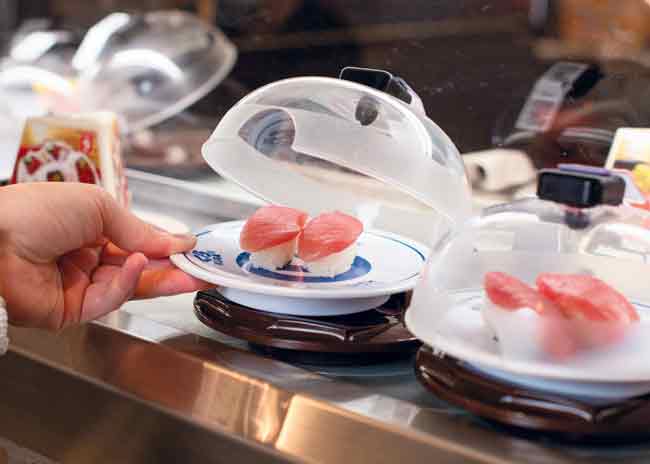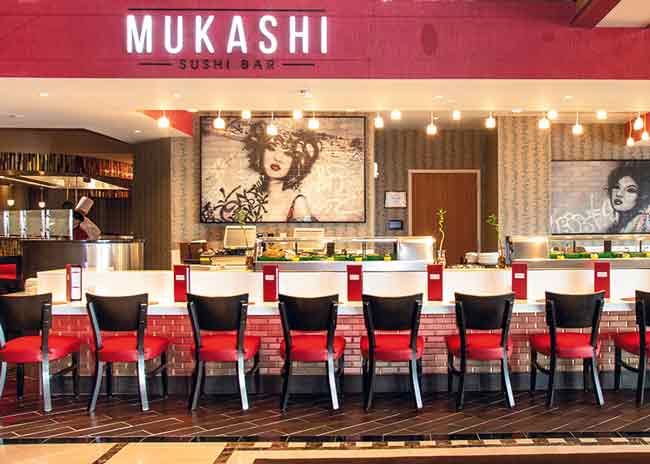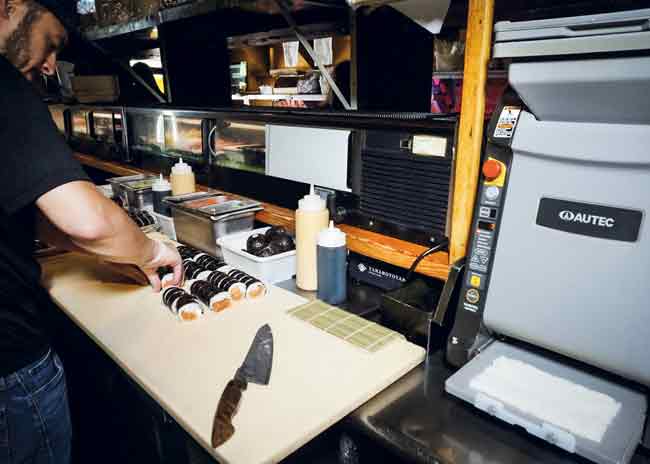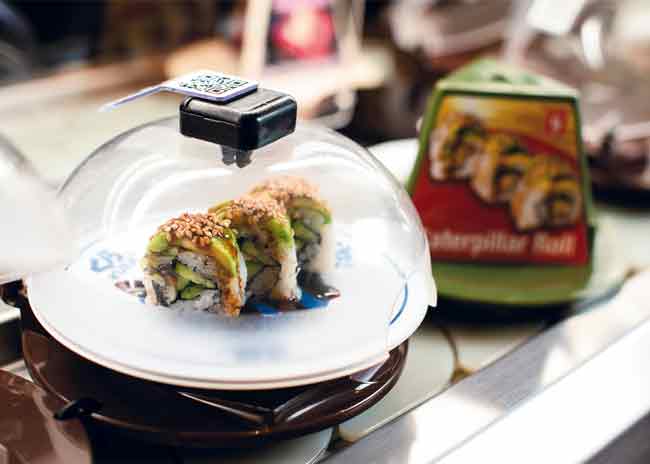Whether designed as a front-of-the-house action station or back-of-the-house area for quick service, functionality and food safety are paramount with today’s sushi stations.
Just like the varied ingredients in sushi, the stations staff use to create these menu items come in different configurations. Designs depend on the operation type and overall goal, yet all include production and refrigeration space.
“The layout and components depend on what you’re shooting for,” says John Marenic, owner of Marenic Food Services Consulting Inc., Charlotte, N.C. “[Whether the design enhances] efficiency or creativity, all typically operate completely differently. The stations will use the same ideas, but the function, appearance and service model may differ, depending on the operation and where it’s located.”
For example, a sushi bar operating from a food court will look and operate differently than one in an upscale Japanese restaurant. “The biggest thing [in terms of the design] is whether there’s seating at a counter, if it’s just grab-and-go — or is it produced in the back of house in a cafeteria setting?” says Michael P. Salvatore, III, senior director, consulting and customer engagement at Ruck-Shockey Associates Inc., which has offices in Truckee, Calif., and The Woodlands, Texas. “One is built for speed, and the other is built for an experience.”
Jimi Yui, owner of YuiDesign, which has offices in New York City and Washington, D.C., was commissioned by prominent New York City sushi chefs to design their stations. This group included Masaharu Morimoto, best known as an Iron Chef on the Japanese TV cooking show “Iron Chef” and its spinoff “Iron Chef America;” and Nobuyuki “Nobu” Matsuhisa, a Japanese celebrity chef and restaurateur known for his fusion cuisine.
Yui says a successful sushi station design will accommodate three basic components: rice, fish and water. “There also are dry ingredients nearby, such as seaweed, sesame seeds, and seasonings and flavorings like wasabi,” he notes. Despite the simplicity of this food, there are specific requirements for the station in which it is prepared.
 This island sushi station designed by Jimi Yui, YuiDesign, enhances the sushi making experience.
This island sushi station designed by Jimi Yui, YuiDesign, enhances the sushi making experience.
Placement Matters
Sushi stations measure 6 feet long on average, and logistics will depend on the operation. If located in the front of the house, John Egnor, managing partner, JME Design, a division of C&T Design and Equipment Co., starts sushi station design on the customer side. “We look at where they are sitting, the shape of the bar and how customers will be served,” he says. “We need to know where they will sit in relationship to the sushi chef. Traditionally, customers sit lower than the sushi chef, and food is presented down, similar to bowing in Japanese culture.”
Common sushi station components include a hand sink, a reach-in refrigerator, a 3-compartment sink and a sushi refrigerator.
Yui says rice is considered the most important sushi ingredient. “The quality of the rice, the way it is cooked, and the infusion of vinegar are key,” he says. Yui notes that chefs typically cook rice in a rice cooker that’s 2 feet in diameter and 6 inches deep with a lot of surface area. Chefs remove the rice from the cooker and spread it out in a container.
 At Kura Sushi, plates are protected by a ventilated sushi lid, which limits airborne exposure. Photo courtesy of Emily J. DavisLike in all foodservice designs, efficiency depends on accessibility. “The sushi chef may have a toaster or convection oven behind this station for grilling, warming or crisping ingredients,” Egnor explains. Fish prep and rice cooking typically occur behind the scenes.
At Kura Sushi, plates are protected by a ventilated sushi lid, which limits airborne exposure. Photo courtesy of Emily J. DavisLike in all foodservice designs, efficiency depends on accessibility. “The sushi chef may have a toaster or convection oven behind this station for grilling, warming or crisping ingredients,” Egnor explains. Fish prep and rice cooking typically occur behind the scenes.
“Other questions we ask: Will this be a traditional or nontraditional counter, and will it be visible from all sides?” Egnor says. “Work surfaces should be stainless steel for easy cleaning, except for wooden cutting boards.”
Having a sink adjacent to the station is critical as staff need to constantly wash knives and hands. “Typically, there will be a hand sink on the right-hand side,” Marenic says. “Some chefs like to use a full-size cutting board, but these are harder to clean. A 3-compartment sink acts like a bar sink, so the 12-inch cutting board can be used on top. Chefs typically have three to four boards.”
Refrigerated display cases sit out in front of these action stations, allowing customers to see the fish in its whole form. “Condiments like wasabi, roe for garnishing and backup fish are typically located in an undercounter refrigerator that isn’t visible,” Salvatore notes. “Because sushi is ambient, the counter space where it is assembled is not refrigerated.”
Along with wooden cutting boards, tools include various sushi knives, bamboo mats for rolling, bowls or warmers for holding rice, and vessels like shallow pans or a speed rail for storing condiments. “You don’t need a ton of ancillary equipment nearby,” Salvatore says. “By nature, these stations are pretty minimalist.”
While front-of-the-house sushi stations add theater, this type may not be suitable for high-volume operations.
In an effort to increase efficiency, Toshio Surihata, founder and CEO of Moshi Moshi, a Miami sushi restaurant, relocated his front-of-the-house sushi bar by the kitchen; now it is no longer visible to guests. “This helps to work efficiently and reduce production time,” he says. “For example, many sushi rolls have tempura, [so having closer proximity to cooking equipment] significantly reduced production time.”
Half of Moshi Moshi’s sales are off-site. Its menu includes 20 types of sushi, sashimi and signature rolls; 14 traditional rolls; ceviche; and crudo. Moshi Moshi’s sushi station consists of a sushi display case, worktop refrigerators, a sushi roll machine and a sushi nigiri machine.
“The equipment is essentially the same for back-of-house sushi stations,” Salvatore says. “The difference is, these typically take up more space. Where a station in the front of house may be 6 feet with one sushi chef, a kitchen station may have three to four people on the line producing sushi for trays that are stored in a cold merchandiser that’s visible to customers. It also will include a small area for packaging grab-and-go sushi.”
 At Mukashi at Resorts International Casino, the sushi bar is customer facing and colorful to match the dishes.
At Mukashi at Resorts International Casino, the sushi bar is customer facing and colorful to match the dishes.
Attention to Detail
The devil is in the details, and there are specific requirements when it comes to working heights.
According to Egnor, a traditional standard table height is 30 inches, but it can be extended to 34 inches with a three-quarters stool. “Looking at the customer side, a 34- to 36-inch-high table requires a three-quarters stool, while a 30-inch-high table will need a standard table-height chair,” he says. “Counters where customers are eating measure about 14 inches deep, and some will have a 4-inch shelf behind them for condiments.”
According to Yui, most sushi counters are at bar height to be casual, while table height is more elegant and formal. “Dining tables are 30 inches high, while the working height in a kitchen is 36 inches,” he says. “In Japan, the floor is depressed to make up the difference. Some stations wind up with a bar height that is in between 30 and 36 inches, and in others, the customer side may be 38 inches, so a hair above the work height.”
In addition to a counter and a refrigerated glass case, a front-of-the-house sushi station includes food shields that protect the prep area. “Depending on how fish is purchased, operators may need to incorporate a blast freezer for storage,” Salvatore says. “This is more common in high-end Japanese restaurants and is based on the quality level of the fish.”
Moshi Moshi created a separate and dedicated room to prepare sushi rice that includes a washer, cookers and a sushi rice mixer, Surihata says.
 In an effort to increase efficiency, Moshi Moshi relocated the front-of-the-house sushi bar adjacent to the kitchen.
In an effort to increase efficiency, Moshi Moshi relocated the front-of-the-house sushi bar adjacent to the kitchen.
Meeting Specific Needs
Some concepts have more unique equipment requirements.
Kura Sushi USA Inc., an interactive, revolving sushi concept, is one example. The chain has grown with more than 600 locations across Japan, Taiwan and the United States.
“Here in the U.S., we offer more than 140 dishes inclusive of nigiri, rolls, hand rolls, gunkan, hot and cold sides, ramen and udon noodle bowls, and desserts,” says Hideto Sugimoto, vice president of supply chain and menu development at Kura Sushi USA, Irvine, Calif. The restaurant delivers sushi to customers dining on-premises via a double-layered conveyor belt system.
“Our sushi station is broken up into three categories: nigiri, rolls and gunkan,” Sugimoto says. “In comparison to non-conveyor belt sushi restaurants, our sushi stations are untraditional as our primary operational focus aside from maintaining the best quality of ingredients is simplicity and efficiency.”
Kura Sushi USA’s equipment includes a conveyor belt, which consists of a revolving sushi bar (bottom layer) and an express belt (top layer), a nigiri sushi machine and a roll sushi machine.
“The revolving sushi bar snakes through the entire dining area with plates of sushi that are protected by our patented ventilated sushi lid, which limits airborne exposure,” Sugimoto explains. “Express belts are positioned above the primary belt. We refer to them as sushi highways as guests can place orders using the tablet at their table and their food zooms directly to them from the kitchen.”
 At Kura Sushi, plates are protected by a ventilated sushi lid, which limits airborne exposure. Photo courtesy of Emily J. DavisThe conveyor belt system runs on a water channel. When guests dispense their completed sushi plates into the table slots, the channel pushes the dishes toward the dishwashing station in the kitchen. “This process helps streamline the checkout process as our tablets track the number of completed sushi plates and number of other items ordered,” Sugimoto says. “So, once guests tap Check Out, servers can bring the tab directly to the customer.”
At Kura Sushi, plates are protected by a ventilated sushi lid, which limits airborne exposure. Photo courtesy of Emily J. DavisThe conveyor belt system runs on a water channel. When guests dispense their completed sushi plates into the table slots, the channel pushes the dishes toward the dishwashing station in the kitchen. “This process helps streamline the checkout process as our tablets track the number of completed sushi plates and number of other items ordered,” Sugimoto says. “So, once guests tap Check Out, servers can bring the tab directly to the customer.”
Although sushi chefs are typically old-school with prep, there have been new equipment developments that have added speed and efficiency to production.
“For real high volume, such as catering or retail, there are sushi machines,” Salvatore says. “Cooked rice is placed in the machine’s hopper, and it cranks out nigiri for individual sushi. There also are machines that sheet rice for rolls.”
Marenic has a patent on refrigerated cutting boards, which are designed to keep products cold and prevent cross-contamination. “It’s good for making sushi at outdoor events,” he says.
Some types of fish, such as bluefin tuna, have specific temperature requirements. “Bluefin is stored in a medical-grade freezer that is -80 degrees C,” Yui says. “It is very important to use this freezer because it can hold product at very frozen temperatures without damaging the cells. As a result, the protein quality is maintained through the freezing and thawing process.”
Yui adds that chefs may instead use Japanese freezers that provide thawing and keep temperature volatility very low. “Because some sushi chefs age fish to specific flavor profiles, we have dry agers in place, or they may wrap fish in seaweed and rest it for a day or two until it’s dehydrated. This produces stronger flavor profiles,” he explains.
According to Surihata, sushi robots are a game changer in this segment. “Although sushi robots create better quality than a human, if the restaurant has a sushi display station, all robots or a machine are not visually good for customers,” he says.
Surihata adds that machines for sushi rolls and nigiri help with speed and quality. “Unskilled sushi chefs make all the sushi rolls and nigiri bigger, while experienced sushi chefs make them smaller,” he says. “The machine helps to keep the portions, quality and speed [uniform].”
Because the biggest issue for sushi chefs is keeping the rice consistent, washers and cookers are often incorporated into the lineup. “It is very hard to keep sushi rice consistent,” Surihata says. “First, washing the rice not only involves rinsing it, but also cleaning the rice surface without breaking it. Second, the water amount to cook rice is tricky. After washing the rice, the chef needs to drain the water well. If not, the water amount for cooking will be different each time. The rice washer machine provides the exact amount of water to cook. The last tool to cook rice is a rice vinegar mixer. Mixing rice with vinegar is a physically hard job, and it is difficult to mix rice and vinegar consistently [without a mixing rice machine].”
The bottom line: Concept will almost always drive a sushi station’s design.
“Define what you are or what you’re trying to accomplish, and the concept becomes the North Star,” Salvatore says. “Every decision becomes completely binary when you have a clear, defined concept.”




